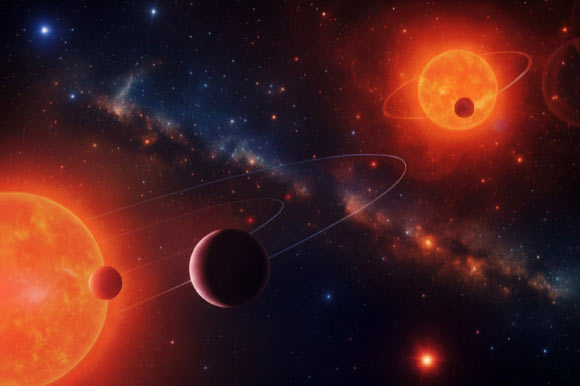The binary stellar system TOI-2267 likely harbors two warm Earth-sized exoplanets and an additional Earth-sized candidate, according to a new paper published in the journal Astronomy & Astrophysics.

An artist’s impression of the binary stellar system TOI-2267. Image credit: Mario Sucerquia, University of Grenoble Alpes.
TOI-2267 consists of the M5-type star TOI-2267A and M6-type star TOI-2267B with a projected separation of approximately 8 AU.
Also known as G 222-3 or TIC 459837008, the system is located around 22 parsecs (73.5 light-years) from our Sun in the constellation of Cepheus.
“Our analysis shows a unique planetary arrangement: two planets are transiting one star, and the third is transiting its companion star,” said Dr. Sebastián Zúñiga-Fernández, an astronomer at the University of Liège.
“This makes TOI-2267 the first binary system known to host transiting planets around both of its stars.”
“Our discovery breaks several records, as it is the most compact and coldest pair of stars with planets known, and it is also the first in which planets have been recorded transiting around both components,” said Dr. Francisco Pozuelos, an astronomer at the Instituto de Astrofísica de Andalucía.
The astronomers detected the three planetary signals using the SPECULOOS and TRAPPIST telescopes as well as their own detection software, SHERLOCK.
“Discovering three Earth-sized planets in such a compact binary system is a unique opportunity,” Dr. Zúñiga-Fernández said.
“It allows us to test the limits of planet formation models in complex environments and to better understand the diversity of possible planetary architectures in our Galaxy.”
The two confirmed planets, TOI-2267b and TOI-2267c, have orbital periods of 2.28 and 3.49 days.
From the current data set, the authors cannot determine which star of the binary these worlds orbit.
They are Earth-sized with radii of 1 and 1.14 Earth radii for TOI-2267b and TOI-2267c, respectively, when orbiting TOI-2267A, whereas the radii are of 1.22 and 1.36 Earth radii when orbiting TOI-2267B.
In addition to the signals attributed to TOI-2267b and c, the researchers detected a third strong signal with a periodicity of 2.03 days.
Its status remains that of a planetary candidate, with a size of 0.95 or 1.13 Earth radii when orbiting TOI-2267A or B, respectively.
“This system is a true natural laboratory for understanding how rocky planets can emerge and survive under extreme dynamical conditions, where we previously thought their stability would be compromised,” Dr. Pozuelos said.
_____
S. Zúñiga-Fernández et al. 2025. Two warm Earth-sized exoplanets and an Earth-sized candidate in the M5V-M6V binary system TOI-2267. A&A 702, A85; doi: 10.1051/0004-6361/202554419







